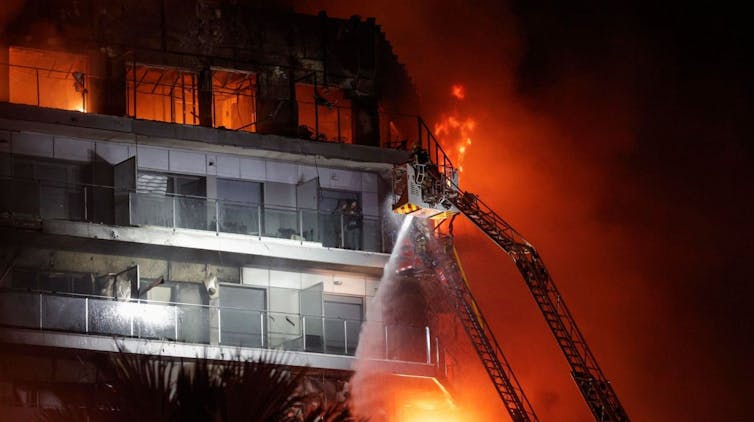
A massive fire has devastated a 14-story building in the Campanar neighbourhood of Valencia, causing a human tragedy for which there is no consolation. Once again, as happened in the Grenfell Tower fire in London, which left over seventy dead, we find ourselves searching for answers on how buildings can become deadly traps.
Alucobond, thermal and acoustic insulation
While the cause of the latest fire in Valencia remains under investigation as of the date of this publication, we already know of several materials that increase the risk of fire and that until recently were widely used in construction, such as the polyurethane contained in Alucobond-type panels.
Alucobond is used as a generic term to refer to a composite material made of aluminum. Most of these compounds are also known as aluminum-plastic panels. These panels typically have a sandwich structure, meaning a central layer of plastic (or other materials, such as inorganic ones), sandwiched between two aluminum panels.
As for the central layer, plastic materials such as polyurethane foam (PU) and polyethylene (PE) were commonly used. Additionally, adhesive resins are used between the central layer and the aluminum layer.
Alucobond-type aluminum-plastic panels have a wide range of applications in construction, such as exterior building cladding, interior decoration, and protective coating on surfaces. Their main function is as thermal and acoustic insulation.
Highly flammable
The materials that make up these panels (plastics, adhesives) are highly flammable. For example, if the central layer is made of untreated PU foam, it is very easy to ignite and spread rapidly. If used as cladding, it can spread throughout the building in a matter of minutes.
It is important to note that some newer types of Alucobond are fire-resistant and use a mineral filler material, instead of flammable plastic, between the outer aluminum layers. But many older buildings do not have this more advanced material.
Just a spark
The danger of using polyurethane foam or polyethylene resin is that any common source of fire could ignite them. This includes cutting sparks, electrical discharges, even unextinguished cigarette butts.
Once the fire starts, other components involved in Alucobond, such as adhesives, will burn rapidly and release smoke and toxic gases. Even the aluminum layer could catch fire if temperatures are high enough.
Technologies to replace them
The ubiquity of these materials makes it impossible to completely eliminate them. However, there is the possibility of working on a more promising and practical approach: making existing materials less susceptible to ignition.
Currently, at IMDEA Materials Institute, four main technologies are being researched that could be used to replace this material or improve fire safety.
- Highly flame-retardant PU foams. It is possible to use them as central materials in Alucobond-type panels, greatly improving the fire safety of the product, especially if used as exterior cladding on buildings.
- Highly fire-resistant aerogel foams. Their fire resistance is much better than that of traditional plastic foam, but they have a similar lightweight and behave similarly in terms of heat and acoustic insulation.
- Highly efficient flame retardant coating. Highly efficient flame retardant coating. In case of fire, to some extent, it will limit the spread of fire and provide more time for people to escape.
- Early fire warning system. Sensors that detect fires before they spread. This technology can be integrated with Alucobond (both in exterior and interior applications). Once the fire starts, in less than 2 seconds, the warning system is activated. Thus, building residents can receive instant notice and evacuate the building immediately.
How to prevent future fires
It is time to carefully review all cladding materials in buildings, especially in older buildings. If any building has flammable cladding, it would be advisable for it to be modified and updated.
It is also essential to use non-flammable cladding materials in buildings through the use of new technologies, especially considering fire safety, release of toxic gases and smoke, etc.
On the other hand, early fire warning technologies are being intelligently implemented in buildings, which will significantly improve property and personal safety.
Additionally, it would be advisable for every family to have some fire-resistant personal items, such as a fire blanket.
But above all, it is necessary to invest in materials that prevent tragedies like the Valencia fire. And that they do not repeat.
De-Yi Wang, Senior Researcher: High-Performance Polymers and Fire Retardants, IMDEA MATERIALS
This article was originally published in The Conversation. Read the original (content in Spanish).
<script type="text/javascript" src="https://theconversation.com/javascripts/lib/content_tracker_hook.js" id="theconversation_tracker_hook" data-counter="https://counter.theconversation.com/content/224300/count?distributor=republish-lightbox-advanced" async="async"></script>
